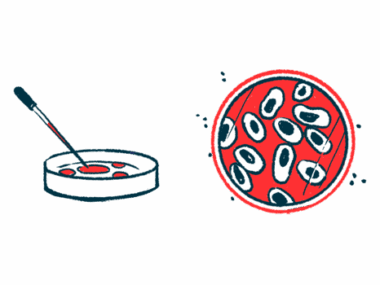Huntington’s Protein Clumps Form Distinct Structures in Nerve Cells
Written by |

Clumps of protein resulting from HTT mutations, the underlying cause of Huntington’s disease, form distinct structures in different parts of the cell, according to detailed imaging analysis.
The findings suggest these clumps form by different mechanisms and may require different therapeutic strategies to block their formation and toxicity that leads to disease, according to researchers.
The study, “Nuclear and cytoplasmic huntingtin inclusions exhibit distinct biochemical composition, interactome and ultrastructural properties,” was published in Nature Communications.
The defect in the HTT gene responsible for Huntington’s disease encodes a huntingtin protein (Htt) with an abnormally long tail of repeats of the amino acid glutamine, a building block of proteins. These extra amino acids cause the protein to form toxic clumps, also called aggregates or inclusions, inside nerve cells (neurons) that eventually lead to cell death and disease symptoms.
Longer glutamine repeats — called polyQ repeats — are associated with early-onset disease; repeats of 75 or more cause the juvenile onset form of Huntington’s.
The detailed structural and biochemical composition of Htt aggregates are not fully known, however, and neither are the mechanisms that drive their formation, clearance, and toxicity. Uncovering these mechanisms may support the development of effective disease-modifying therapies to treat the disease.
To identify aggregates in different cell compartments — such as the nucleus or the cytoplasm outside the nucleus —and study their structural features inside cultured neurons, researchers at the Swiss Federal Institute of Technology Lausanne, Switzerland, applied an advanced technique known as correlative light-electron microscopy (CLEM).
First, a mutant version of Htt with 72 glutamine repeats was over-produced in HEK 293 cells, a type of human cell line used for preclinical research in the laboratory.
CLEM analysis showed the outer layer shell of the aggregates contained fiber-like (fibrillar) structures that were tightly packed and radiated from the core, where the fibers appeared to be more tightly organized and stacked. This suggested that “both the core and shell contain aggregated fibrillar forms of mutant Htt but with a distinct structural organization,” the researchers wrote.
Images revealed that the core and the shell of the aggregates contained many small membrane-like structures. Damaged energy-producing mitochondria were present in the outer surface, but weren’t seen in the center. Also, proteins that maintain cell structure, such as actin and tubulin, were mainly found in the outer shell.
In the nucleus, the fibrillar structures didn’t exhibit the core and shell organization seen in cytoplasmic aggregates, nor did they contain the membrane-like structures trapped within the core, suggesting that “the intracellular environment is a key determinant of the structural and molecular complexity of the inclusions and that nuclear and cytoplasmic inclusion formation occurs via different mechanisms,” the researchers said.
Since studies suggest the polyQ repeat length strongly influences the aggregation properties of the Htt protein, the researchers tested different polyQ lengths of 16Q, 39Q, and 72Q. No significant cell death was observed in cells over-producing 16Q or 39Q, whereas cells expressing 72Q died. No aggregates were seen in cells with 16Q; aggregates were found in cells expressing 39Q, but at lower numbers compared to 72Q (16% vs. 38%).
“Altogether, our data establish that polyQ expansion plays a critical role in determining the final architecture and ultrastructural properties of the [Htt aggregates],” the researchers wrote.
Part of the Htt protein — Nt17 domain — plays an important role in regulating the location of Htt in cells and has been shown to impact aggregates’ formation. While removing the Nt17 domain reduced aggregation, it did not influence the organization and structural properties, suggesting the interaction between fibers and other proteins and cellular components was likely mediated by another, more flexible part of the Htt protein, called the PRD domain.
Further analysis showed that aggregate formation involved actively recruiting and sequestering cellular proteins, fats and fat-like molecules (lipids), and other cellular components. Aggregate formation also impacts energy-producing mitochondria’s structure and function.
The team next investigated the aggregates’ impact on neurons isolated from brain tissue. The over-production of 16Q Htt protein did not form aggregates after 14 days. In contrast, over-production of 72Q induced the formation of round-like aggregates in the nucleus of almost all neurons test after three days. Less than 1% of neurons showed aggregates in the cytoplasm.
By day seven, these aggregates appeared dense and round without a core and shell organization. They still contained fiber-like structures that were not closely stacked in parallel, but organized as a network of twisted filaments. Imaging was unable to find membrane- or compartment-like structures inside.
Although removing the Nt17 domain did not affect the aggregates’ structural properties or composition, it significantly accelerated the formation of large aggregates.
Among the small aggregates within the nucleus, a few were seen near the nuclear membrane, which appeared damaged. The nuclei containing 72Q aggregates showed enhanced nuclear shrinkage over time, “indicating increased neuronal toxicity,” the scientists wrote.
“These results demonstrate the formation of condensed mutant [Htt] fibrillar aggregates within intranuclear inclusions in neurons and suggest that the process of their formation and maturation is directly linked to neuronal dysfunctions and cell death,” they said.
Finally, the impact of adding a green fluorescent protein (GFP) attached to Htt was examined. Adding GFP to Htt has been widely used in Huntington’s cellular models to visually monitor protein aggregation.
The addition of GFP to Htt induced aggregates with different structural organization and toxic properties than Htt alone and demonstrated distinct compositions in the nucleus and cytoplasm.
“Our findings also caution against the use of large fluorescent protein tags to develop disease models of [Huntington’s disease] and screen for drugs that modify Huntingtin aggregation and inclusion formation,” study lead Hilal Lashuel said. “This has significant implications for Huntington’s disease and other neurodegenerative diseases, where fusion of fluorescent proteins is commonly used to investigate mechanisms of protein aggregation and in drug discovery.”
“We show that Htt aggregation and inclusion formation in the cytosol and nucleus occur via different mechanisms and lead to the formation of inclusions with distinct biochemical and ultrastructural properties,” the researchers wrote. “These observations suggest that the two types of inclusions may exert their toxicity via different mechanisms and may require different strategies to interfere with their formation, maturation, and toxicity.”
“Therefore, we believe that targeting inclusion growth and maturation represents a viable therapeutic strategy,” they added.
“Our work opens up new insights into the composition and ultrastructure of huntingtin inclusions,” Lashuel said. “They advance our understanding of the mechanisms of huntingtin aggregation but also point to new directions for therapeutic interventions, which we plan to pursue.”







